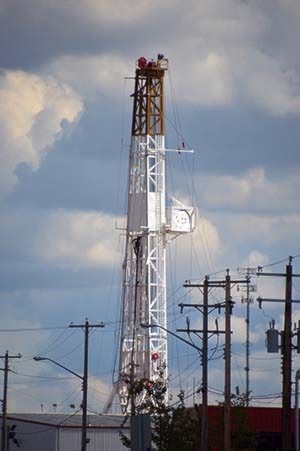With the impending Alberta carbon levy taking effect Jan. 1, 2017, businesses and families alike are questioning how the levy will affect them and what they can do to help mitigate the rising costs.
In order to help answer some of the questions the Leduc Nisku Economic Development Association hosted a Carbon Tax Implications Breakfast Sept. 14.
Guest speaker Mitch LaBuick, senior manager or indirect tax services with Meyers Norris Penny LLP, walked people through the basic structure of the carbon levy.
According to the Government of Alberta website the carbon levy is the most cost-effective way to reduce greenhouse gasses and will reward families, businesses and communities who takes steps to reduce their carbon footprint.
“What is Bill 20 and the new Alberta Carbon Levy? It’s a broad based tax that will be levied on the purchase of the fossil fuels that produce greenhouse gasses,” said LaBuick.
“That’s going to affect the day-to-day, such as heating and transportation,” he added.
Starting Jan. 1 the carbon levy will be applied to fuels at a rate of $20 per tonne; that will increase to $30 per tonne Jan. 1, 2018.
“Your gas at the pump will be applied on the per litre basis,” said LaBuick.
He says the tax also applies to fuels imported and sold in Alberta after being removed from infrastructures (refineries).
Exemption include fuels bought or used on reserve land, fuel focused in the agricultural industry on farm sites and large industrial emitters who will not have to contribute for the time being, as they are already subject to the Specified Gas Emitters Regulation performance standards framework.
“Obviously any fuel exported outside the province,” LaBuick added.
Electricity is also excluded from the Alberta Carbon Levy.
“You will notice the exemptions don’t really include: charities, not-for-profit, municipalities,” said LaBuick.
A rebate program will provide money back to those eligible. The rebate will provide up to $200 for an adult, $100 for a spouse, and $30 for each child under 18 in the household up to a maximum of 4 children. Individuals earning more than $55,000 annually will receive no rebate, nor will couples earning more than $102,000 annually, says LaBuick.
To provide small businesses a relief Alberta’s small business corporate income tax rate will be reduced by one-third, effect on Jan 1, 2017.
With the carbon levy increasing the costs of greenhouse gas-inducing fuels and impacting transportation and heating, LaBuick says it stands to reason other sectors will be impacted as well. “Are businesses prepared to absorb the costs?”
With businesses having to pay more to heat buildings and transport materials — and minimum wage scheduled to increase Oct. 1 — the costs of goods and services may increase to subsidize.
During the breakfast LaBuick was asked how effectively and efficiently the funds are going to be directed back into the economy.
The Government of Alberta website states, “The carbon levy is the key tool that will pay for the transition to a more diversified economy. Over the next 5 years, the levy is expected to raise $9.6 billion.”
“As with all taxes we don’t really know how that tax will be applied until three of four years down the road,” said LaBuick.
Mitch Pomphrey of Pomphrey Industries spoke doing the breakfast about tactics families and businesses could take to help mitigate the effects of the levy.
His presentation focused on changing perceptions of utilities as a fixed expense.
^
“A lot of people are griping right now about the carbon tax stifling economic growth,” said Pomphrey.
He says, like a recession, the carbon tax will push people to generate new business models and look to industry for solutions.
One tactic to help offset fuel transportation costs is replacing fleets that use conventional fuels , says Pomphrey.
Energy efficient lightbulbs was another of Pomphrey’s main points; by using energy efficient bulbs to reduce electricity costs, the savings could then be applied to temper rising costs created by the levy.
